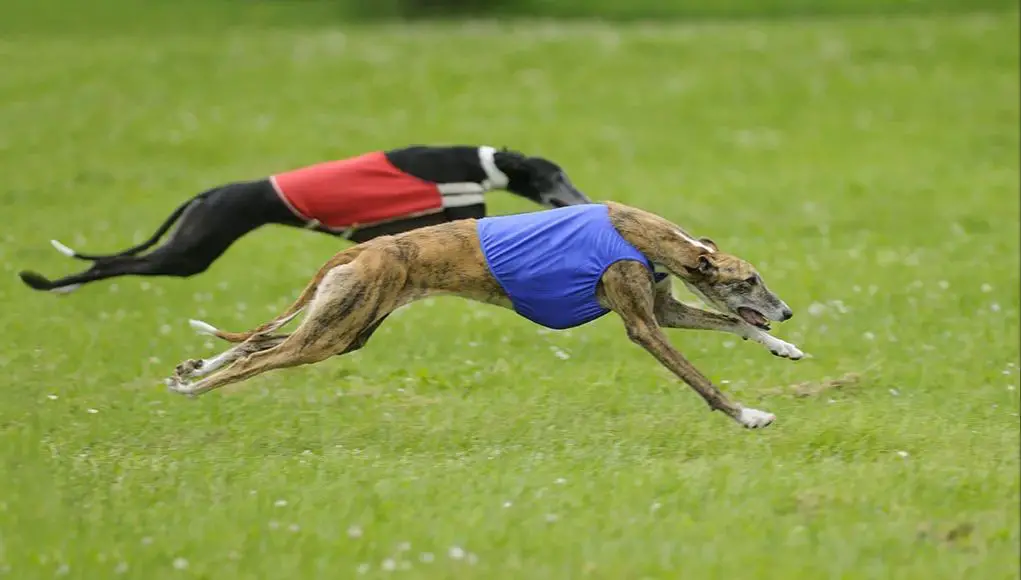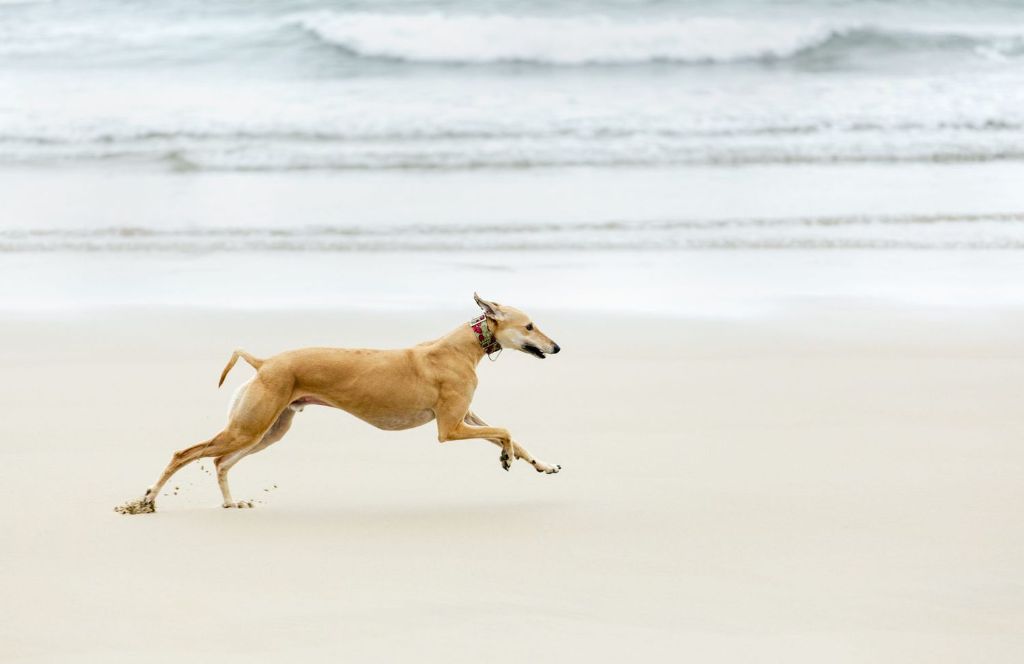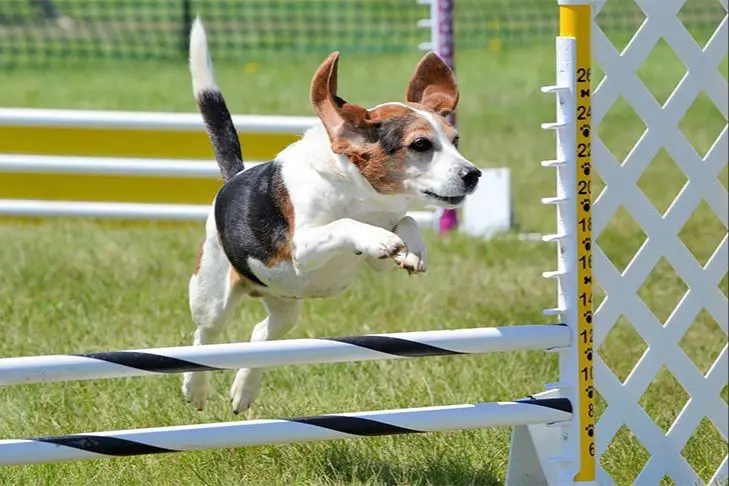Introduction
One of the most impressive aspects of dogs is their running speed. A dog’s quick acceleration and high top speed can seem almost unbelievable at times. Many dog owners have watched their pets zoom by at incredible rates and wondered – just how fast can dogs really run?
In this article, we’ll take an in-depth look at the top speeds different dog breeds are capable of, factors that affect how fast dogs can run, whether speeds of 20 mph are feasible for dogs, typical speeds for pet dogs, how to train dogs for speed, speed competitions for canine athletes, and potential health impacts of extreme running speeds in dogs.
By the end of this article, you’ll have a much better understanding of exactly what types of speeds dogs are able to achieve.
Top Speeds for Different Dog Breeds

When it comes to sheer speed, certain dog breeds stand out for their lightning-fast running abilities. Here are some of the fastest breeds and their top recorded speeds:
The Greyhound is considered the fastest dog breed, capable of sprinting up to 45 mph. These slender, long-legged racing dogs have a flexible spine that allows them to efficiently contract and extend their legs when running, powering them to blazing speeds.
Another fast sprinter is the Vizsla, a hunting dog bred to chase prey over long distances. On a straight race track, Vizslas can reach speeds up to 40 mph at their peak.
The energetic Dalmatian is also known for its sprinting abilities, able to run up to 35 mph if trained for athletic performance. Their stamina allows them to maintain a fast pace over long distances.
While most dogs can run at speeds up to 20 mph or more in short bursts, these breeds stand out for their ability to sustain rapid speeds of 30+ mph.
Factors Affecting a Dog’s Top Speed
A dog’s breed and size play key roles in determining its top running speed. In general, larger dog breeds with longer legs tend to be faster runners. Sighthounds like greyhounds, salukis, and whippets were bred for hunting by sight and have an athletic build designed for speed and endurance. Smaller dog breeds with short legs like dachshunds, basset hounds, and corgis have lower top speeds. Though large working breeds like German shepherds and huskies can reach speeds over 30 mph, sleek-bodied greyhounds are among the fastest, capable of surpassing 40 mph at their peak.
Beyond inborn attributes like breed, other factors like health, fitness level, and training influence a dog’s speed capacity. A dog that is overweight or suffering from joint issues or other health problems will likely have slower speeds than a fit dog in good athletic shape. Regular exercise and training to improve cardiovascular conditioning allows dogs to run faster and sustain higher speeds. Motivation also plays a role – some dogs inherently love to run full speed ahead, while others may be more inclined to trot or gallop leisurely unless being vigorously trained for racing or coursing. Proper warmup, cooldown, stretching, and conditioning helps maximize a dog’s speed potential.
20 MPH – Is it Possible?

When looking at the top speeds dogs are capable of, the magic number of 20 mph is sometimes thrown around. But is it really possible for a dog to run 20 miles per hour?
According to research, most dog experts agree that very few breeds are actually capable of hitting speeds of 20 mph or greater.
The fastest dog breeds like the Greyhound and Whippet can reach speeds of up to 45 mph, far exceeding 20 mph. These professional racing dogs are bred for speed and have lean bodies built for sprinting.
Certain other athletic breeds like Border Collies, Jack Russell Terriers, and Australian Shepherds may be able to reach 20 mph briefly, especially if descending a hill. However, these speeds would be difficult to sustain over a long distance on flat ground.
For your average house pet, achieving a full-out speed of 20 mph is highly unlikely. Most family dogs top out at closer to 10-15 mph. Factors like size, build, and fitness determine a dog’s top speed.
So while specialized breeds under ideal conditions can definitely exceed 20 mph, it remains an ambitious benchmark for most dogs. Claims of pets reaching such speeds may be exaggerated without proper documentation and testing.
Typical Speeds for Pet Dogs
The average pet dog is only capable of running around 15-25 mph at their top speed. Some of the most common pet breeds like labrador retrievers and beagles typically top out around 15 mph. Border collies, an active herding breed, average around 20-25 mph. These dogs simply aren’t built for high speed sprinting like greyhounds or other racing breeds.
Some smaller dog breeds don’t speed up that much at all. Poodles and french bulldogs often reach just 10-15 mph even when running all-out. For these apartment-sized pets, shorter burst sprints are more common than long distance running. On the other hand, working dog breeds like Australian Shepherds and Dalmatians can get closer to 25 mph since they have higher exercise needs and were bred for running and herding livestock over long distances.
While unusual, it’s not impossible for a pet dog to hit 30 mph if they are extremely athletic or have some mix of sprinting breeds in their lineage. However, your average house pet is unlikely to come close to top speeds of elite racing greyhounds or huskies. Factors like size, fitness, breed traits, and age also impact how fast any individual dog can run.
Speed Training for Dogs

Some owners may want to improve their dog’s top speed through specialized training programs and techniques. This is most common among owners who participate in canine sports with their dogs, such as agility, flyball, or racing. Here are some effective methods for improving a dog’s speed:
Interval Training – This involves alternating between periods of high-intensity running and recovery. Start with short distances like 10-30 seconds of sprinting followed by 1-2 minutes of rest, then gradually increase the sprint duration as your dog’s stamina improves. The rest periods allow the cardiovascular system to recover.
Uphill Sprints – Running uphill requires more power and effort from your dog. Start with low-grade hills and have your dog sprint up, then walk back down. Increase the length and incline as your dog gets fitter. This builds rear leg strength.
Resistance Training – Adding resistance when running, through activities like pulling weighted sleds or swimming, forces your dog to exert more energy. Start with low resistance and increase over time. This enhances overall muscle development.
Off-Leash Running – Dogs tend to run faster when not tethered to a human. Let them run freely in a safe, enclosed area to tap into their natural speed. Reward them for staying near you.
Agility Equipment – Jumps, tunnels, weave poles and other agility equipment can encourage faster running and turning. Make sure your dog is trained first. Only do low impact equipment until your dog is fully grown.
As with any athletic training, gradually build up your dog’s speed work over several weeks to avoid injury. Monitor for signs of fatigue, soreness or lameness. Dogs also need proper nutrition, hydration and rest days for their training to be effective. Always consult your veterinarian first before starting a structured speed program.
Speed Contests for Dogs
There are a number of major speed contests for dogs that aim to record some of the fastest speeds dogs are capable of reaching. Some of the most well-known events include:
- The Fastest Dogs USA competition – This event is held annually in multiple locations across the United States. It utilizes an electronic timing system to precisely record speeds as dogs sprint 100 yards. The current record holder ran over 38 mph in the 2018 competition.
- The Superdog National Championships – At this annual event, dogs compete in several categories including a 100-yard dash. The top speeds recorded are typically over 30 mph.
- The Purina Incredible Dog Challenge – This televised event has a 30-yard sprint competition to showcase speed. While a short distance, top dogs can reach over 20 mph.
- The AKC Fast CAT (Coursing Ability Test) program – These timed 100-yard dashes authorized by the American Kennel Club record each dog’s speed. The fastest dogs can finish in under 3 seconds, which equates to over 30 mph.
These major speed competitions offer specially designed courses or timing systems to precisely record just how fast dogs can run when sprinting at top capacity. The fastest dogs setting new records at these events show that some breeds certainly have the capability for short bursts of speed over 30 mph.
Health Impact of High Speeds
While some dogs are capable of reaching speeds of 20 mph or more, especially over short distances, running at their top speed for an extended period can put a lot of strain on their bodies and pose some health risks.

When running at high speeds, dogs are exerting themselves at maximum capacity. Their heart and lungs have to work overtime to deliver oxygenated blood to the muscles. Panting helps dogs cool themselves, but they can overheat if pushed too hard.
The impact forces generated when running at high speeds also place a lot of stress on a dog’s joints, especially the hips and knees. Dogs that run on hard surfaces like concrete are prone to injuries like strained tendons, ligaments or muscle tears. Osteoarthritis can develop over time.
High-speed running can also lead to foot injuries like cracked toe nails, blisters or cuts on the paws. Dogs with longer ears may be prone to “ear hematomas” as their floppy ears flap forcefully while running.
Thus, while dogs may be capable of short sprints of 20 mph, it’s best to avoid having them run at their top speeds for too long to prevent orthopedic injuries or overexertion. Monitoring dogs when running and providing rest periods is important.
Unique Abilities
While pure speed is impressive, dogs also have many unique abilities that enable their athletic feats. For example, dogs have a lean body build designed for running, with long legs, flexible spines, and muscles concentrated at the loins and shoulders. Their light skeletal structure and narrow waist make them very agile.
Certain breeds also have tremendous endurance thanks to adaptations like a deep chest to accommodate larger hearts and lungs. Huskies and other sled dogs can run up to 100 miles per day. In stage races like the Iditarod, they cover nearly 1000 miles in 8-15 days.
Dogs also have a swift response time and can accelerate rapidly by quickly contracting their fast-twitch muscles. Greyhounds can go from 0 to 40 mph in just 3-4 strides from a standing start. Their supple muscles allow legs to open wide for longer strides.
Physical adaptations like non-restrictive shoulders, loose skin, and hair between toes give dogs great agility to change directions instantly at high speeds. These unique abilities all enable dogs to reach impressive top speeds.
Conclusion
To summarize, while most dogs top out at speeds between 15-25 mph, with faster breeds like Greyhounds reaching peaks over 40 mph, it’s rare for an average pet dog to hit 20 mph. Certain elite canine athletes who train extensively and compete in racing events may be capable of briefly hitting around 20 mph or slightly higher at full gallop over short distances. However, maintaining that kind of extreme speed is unsustainable for more than a few seconds without risking injury. For pet dogs, much slower paces within a range of 6-15 mph are more realistic for play or exercise. While fascinating exceptions exist, 20 mph is generally beyond the normal limits for canine physiology. Therefore, while possible in unique circumstances, a sustained speed of 20 mph remains an impressive and uncommon feat among the general dog population.